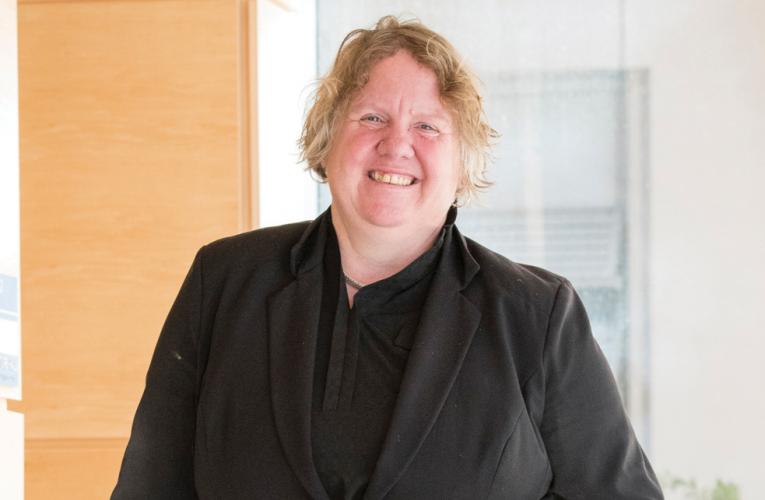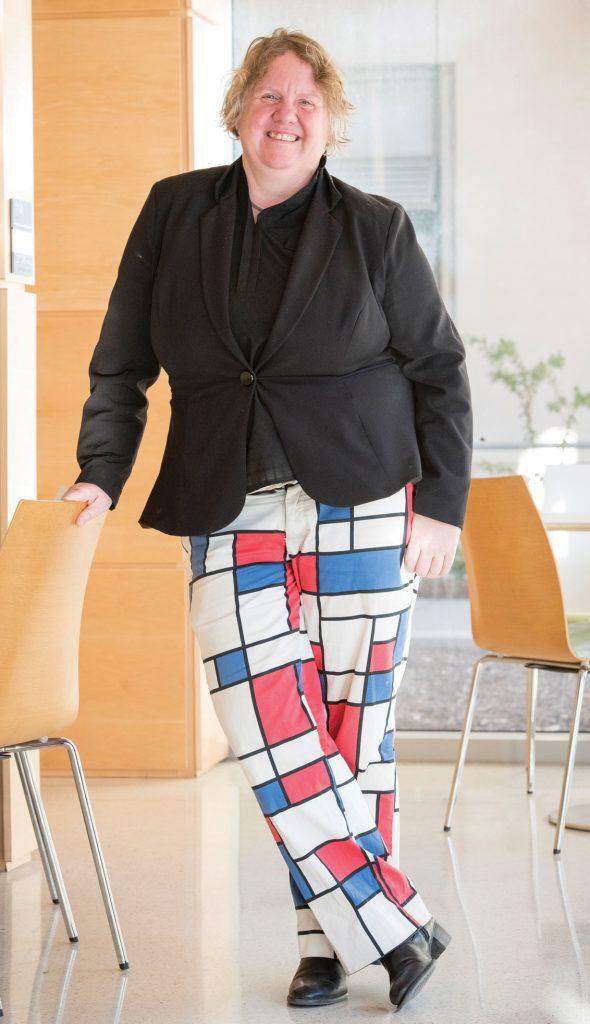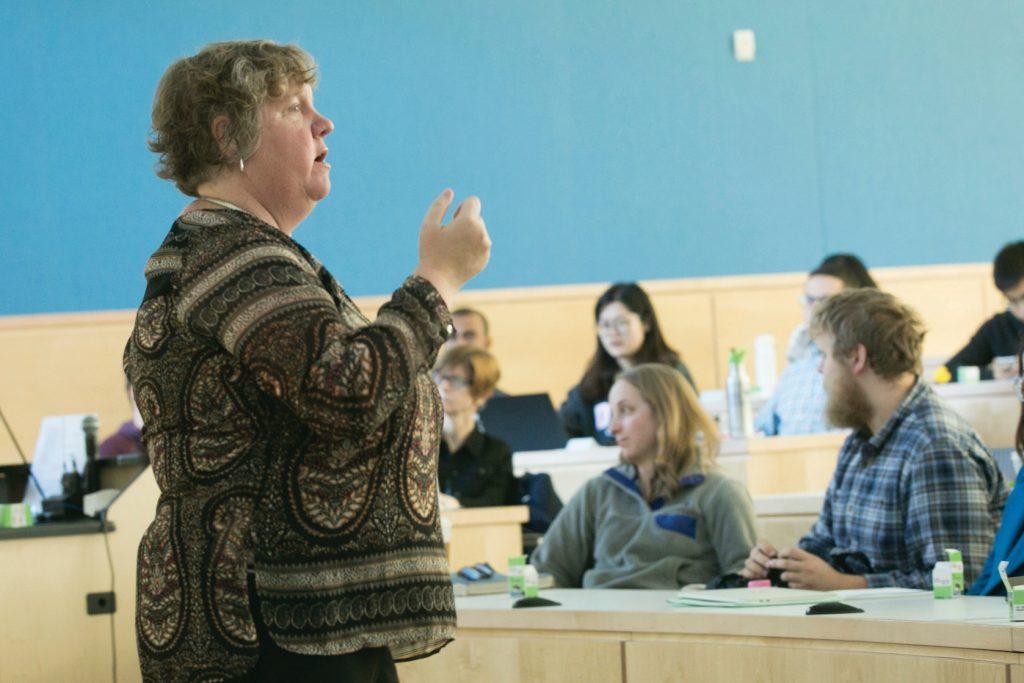Tim Lucas
(919) 613-8084
tdlucas@duke.edu
BY CATHERINE CLABBY
On a sunny late morning last fall, Betsy Albright handed her data analysis students plastic click counters while briefing them on what sounded like a simple assignment.
“Good morning everybody. Please find your name on the spreadsheet and sit in the groups one, two, three, four, five, six, seven, eight, ” Albright instructed from the front of Field Auditorium.
Albright had the Nicholas School graduate students fan out in groups across campus to assess how hospitable specific spots were for bike riding. They carried their click counters to tally how many bicycles, cars and pedestrians they saw.
Within minutes, challenges to collecting just that little bit of data popped up.
“Is this area safe for biking?” Jeff Meltzer asked fellow students stationed by a nearly empty traffic circle outside the Bryan Center.
“It depends on the time of day. This spot is usually crowded,” responded Zainab Qazi.
“This is kind of a bike path?” Meltzer said cautiously, as he and others puzzled over how to label a well-used sidewalk that cyclists sometimes use.
Observing challenges to collecting clean data was at the heart of Albright’s lesson.
“There are problems with subjectivity. You can say that in class a hundred times but it’s helpful to see it, ” says Albright, an environmental policy researcher and a very popular teacher in Environment Hall.
FINDING KNOWLEDGE IN DATA
Good data exists, of course, and so does good analysis. But whether teacher Applied Data Analysis for Environmental Science or pursuing her own research, Albright makes one thing very clear: Both require gobs of work.
Albright got interested in the quality of information used to craft and implement environmental policy long before she joined Duke’s faculty in 2011. After studying chemistry at The College of Wooster, Albright tried working in a research lab at Case Western Reserve University. But repetition on the job and so much time indoors left Albright, a painter as well as a researcher, uninspired.
Looking for adventure, Albright in 1994 followed a friend from her youth to a teaching job in rural Hungary with a program started by a former Peace Corps volunteer. She loved helping middle-school-aged pupils learn English. But she was startled by the environmental degradation in water and air that she encountered in a land only recently free from the Soviet bloc.
“There was a lot of particulate matter. It made for some really cool sunsets, but you noticed the poor air quality,” Albright says.
Albright returned to the United States to acquire tools to try to address environmental problems. She enrolled in two master’s degree programs to study environmental science and environmental policy at the School of Public and Environmental Affairs at Indiana University.
That training landed her a job at the EPA in Research Triangle Park and then another with the water quality division of what is now North Carolina’s Department of Environmental Quality. The state job unintentionally taught Albright how not to help citizens protect their environment.
“I was a water quality modeler. We’d go out to towns in North Carolina and talk to farmers about what they should do based on the models. That didn’t go well with the farmers,” who knew a lot more about their land than computers did, Albright says.
“I thought there should be a better way,” she adds.
So, she returned to the classroom, this time at Duke to earn a doctorate at the Nicholas School. In Durham she dove into topics such as collaborative decision making and, eventually, what it takes for communities to embrace environmentally minded changes after disasters.
Her dissertation research and a Fulbright scholarship brought her back to still newly democratizing Hungary, a lowland nation with a long history of damaging flooding. With interviews of flood and water policy experts, as well as surveys of 141 mayors of towns in river basins, she probed how extreme floods from 1998 to 2002 influenced governments.
Simply experiencing flooding wasn’t enough to produce policy shifts from engineering solutions to more ecological solutions, she found. Allowing citizens with ecological leanings and scientific evidence to be part of the conversation helped, she observed.
Eight years into her career as a social scientist, Albright is still exploring what conditions help communities promote ecological and social resilience after disasters.
“Resilience, in my mind means to learn from, adapt to and become stronger in the face of future risks. This could be at the community or household level, with the goal that communities and households are more prepared to face future risks,” Albright says.
Albright is well equipped for the task, says Deserai Anderson Crow of the University of Colorado, one of Albright’s collaborators.
“Betsy has this incredible combination: She’s a great statistician and her comfort with quantitative methods is fantastic. And she has this totally creative very humanist side to her,” Crow says.
LISTENING, DOCUMENTING & DECODING
Understanding how communities can learn from catastrophes to better meet all residents’ needs is relevant after any environmental crisis, from toxic chemical spills to tsunamis. But given that global climate change is expected to produce more flooding, wildfires, and other natural disasters, the work may be more relevant today than ever.
Such concerns take Albright to where trouble strikes, including Columbia, S.C., in 2016 after severe flooding there. With funding from Bass Connections, she, a Social Science Research Institute staff member and Duke undergraduates parked a 37-foot RV converted to research vehicle in a downtown Piggly Wiggly parking lot. They surveyed more than 100 residents and recorded around 50 people answering this query about the floods: “Tell us about what happened and how it affected you.”
Albright and Crow are collaborating on a more intensive study in Colorado, where they are comparing responses in seven communities to severe flooding in 2013. Some 18 inches of rain fell in the densely populated Front Range foothills that year, mostly in three days.
Resulting floods destroyed some homes and damaged others to the point where people had to abandon them until they were repaired. Water also ripped up roadways and harmed public buildings, businesses, and park land. This National Science Foundation-funded project is analyzing how communities make decisions about whether, where, and how to rebuild, as well as whether to adopt changes in zoning and floodplain uses.
Albright and Crow are deeply interested in whether the decisions are protective or maintain conditions that leave people and property vulnerable to future flood events. They are also probing how open community leaders are to public involvement in their decision making.
It’s a big job, requiring social science tools such as text coding, specialized software, and case study approaches to dig in.
With help from research assistants, the research teams have interviewed and surveyed hundreds of government officials and residents about how well authorities involved residents in flood recovery planning, whether community resources were adequate, and if alternative plans for managing flood risks are needed.
They also reviewed some 1,825 community documents that don’t often get much attention, including municipal press releases, city council and task force minutes, government board memos, etc. They have and will continue to share their findings with the communities under study.
“I don’t want our research to be extractive but to give back,” Albright says.
LIGHTING THE SPARK
As she did all those years ago in Hungary, Albright still loves teaching. These days she instructs within and beyond traditional classrooms.
In 2014 she launched an iPad and iPhone application called stats! to tutor anyone interested on statistical vocabulary and practices by spelling out the importance of probability, the power of sampling, simple and multiple regression, generalized linear models and more.
“I tried not to dumb things down but to write in a way that is not super jargony, or full of symbology that people don’t understand,” Albright says of stats!, which she illustrated with her own abstract artwork.
The impact is palpable in online reviews for stats!, which averages 30 downloads a day. “This app single-handedly rescued my sanity,” one user wrote. “Other texts give well-crafted and complete explanations, but it was here that I found the actual process of statistical analysis step by step.”
Albright’s impact was clear, too, after the Thanksgiving break in her data analysis class. This time small teams of students stood one after another to present progress on projects digging into publicly available data sets. After months under Albright’s tutelage, the students were well equipped to weave together multiple data sets, including information from World Bank reports, U.S. county-level voting records, nonprofit group survey findings, and much more.
Using qualitative tools such as multilinear regression, heteroscedasticity, multicollinearity and p values, they sought answers to big questions. What factors explain carbon dioxide emissions in Latin America? Which features most strongly advance gender equity in a society? What increases risk of malnourishment globally? And what is the education and political profile of North Carolinians concerned about climate change?
After each group presented their work in progress, Albright applauded, asked questions, and offered suggestions.
“Do you have any information on the percent of the county’s economies depending on natural resources, like fishing?” she queries the group exploring variation in sentiments about climate change.
Having direct contact with nature might influence a person’s views about the reality of climate shifts, she explains.
In other words, she urged the students to keep thinking. And to keep asking. “Try to get more granular,” she counsels.
Catherine Clabby is a journalist who writes about science and the environment. She lives in Durham, NC.







